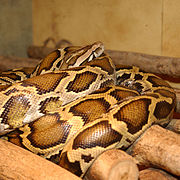Pythonidae
| Pythonidae | ||||||||||||||||
|---|---|---|---|---|---|---|---|---|---|---|---|---|---|---|---|---|
 Indian python, Python molurus | ||||||||||||||||
| Scientific classification | ||||||||||||||||
| ||||||||||||||||
| Synonyms | ||||||||||||||||
|
- Common names: pythons.
The Pythonidae are a family of non-venomous snakes found in Africa, Asia and Australia. Among its members are some of the largest snakes in the world. Eight genera and 26 species are currently recognized.[2]
Contents[hide]
|
[edit] Description

Adults range in size from 0.5 to 9.75 meters (1.5 to 32 feet) in length. One species, Python reticulatus, the reticulated python, is probably the world's longest snake.
The Pythonidae are distinguished from the family Boidae (boas) by the fact that they have teeth on the premaxilla: a small bone at the very front and center of the upper jaw. Most species have rows of heat-sensing organs between the sublabial scales: labial pits. Although not as well developed as the loreal pits of the subfamily Crotalinae (pitvipers), these organs enable the snakes to detect objects that are hotter than the surrounding environment, and enable hunting to take place in total darkness, such as inside caves.
Some species exhibit vestigial bones of the pelvis and rear legs, which are externally apparent in the form of a pair of anal spurs on each side of the cloaca. These spurs are larger in males than females, and are used by the male to grip and/or stimulate the female during copulation. Males of certain species occasionally cause spur related injuries to each other during territorial combat, and though more likely to be incidental than intentional, some captured specimens have shown multiple episodes of scarring from such injuries.
Color patterns vary from striking to nondescript brown or green. It usually reflects appropriate camouflage for the native habitat. Even within a given species, there may be enormous differences in coloration and pattern in different parts of the geographic range.
[edit] Geographic range
Found in subsaharan Africa, peninsular India, Myanmar, southern China, Southeast Asia and from the Philippines southeast through Indonesia to New Guinea and Australia.[1]
In the United States, a population of Burmese pythons, Python molurus bivittatus, has existed as an invasive species in the Everglades National Park since the late 1990s, which has damaged the local ecosystem. More than 300 have been removed. They are not native to the south Floridian marshlands, but have been deposited there by pet owners who no longer wished to care for them and also did not want to euthanize them. Scientists believe that the snakes are a grave threat to nearly every species of animal in the Everglades, including alligators. There have been several accounts of python versus alligator encounters there, including one in autumn 2005 between a 13-foot (4 m) python and a six-foot (1.8 m) alligator that proved fatal for both. The two were found with the alligator's body protruding from a tear in the snake's body. [3]
[edit] Conservation
Many species have been hunted aggressively, which has decimated some, such as the Indian python, Python molurus.
[edit] Behavior

Aspidites melanocephalus
Most members of this family are ambush predators, in that they typically remain motionless in a camouflaged position and then strike suddenly at passing prey. They will generally not attack humans unless startled or provoked, although females protecting their eggs can be aggressive. Large adult specimens can kill people. Unsuspecting children can and have been preyed upon and swallowed whole after being suffocated. Reports of attacks on human beings were once more common in South and Southeast Asia, but are now quite rare.
[edit] Feeding
Prey is killed by a process known as constriction; after an animal has been grasped to restrain it, a number of coils are hastily wrapped around it. Then, by applying and maintaining sufficient pressure to prevent it from inhaling, the prey eventually succumbs due to asphyxiation. It has recently been suggested that the pressures produced during constriction cause cardiac arrest by interfering with blood flow, but this hypothesis has not yet been confirmed.
Larger specimens usually eat animals about the size of a house cat, but larger food items are not unknown: some large Asian species have been known to take down adult deer, and the African rock python, Python sebae, has been known to eat gazelle. Prey is swallowed whole, and may take anywhere from several days or even weeks to fully digest. Despite their intimidating size and muscular power, they are generally not dangerous to humans.
Contrary to popular belief, even the larger species, such as the reticulated python, P. reticulatus, do not crush their prey to death; in fact, prey is not even noticeably deformed before it is swallowed. The speed with which the coils are applied is impressive and the force they exert may be significant, but death is caused by suffocation, with the victim not being able to move its ribs in order to breathe while it is being constricted.[4][5][6]